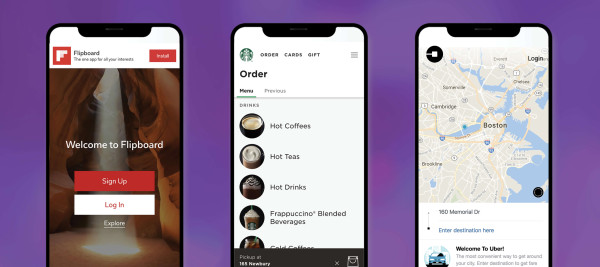How Progressive Web Applications Are Outpacing And Outperforming the Native App

![How Progressive Web Applications Are Outpacing [And Outperforming] the Native App](https://www.trainor.com/assets/Uploads/TRAINOR-Blog-Header-1.jpg)
Designing a website or an app with the user in mind is sort of a no-brainer in the digital marketing world. A Progressive Web App (PWA) takes your website and your native app and smooshes them together, marrying the user’s experience on the web with their experience on the app so that they are, hopefully, one and the same.
Ok, so no one really smooshes anything. It’s all pretty technical and full of computer jargon, so let’s break it down. We’ll look at a basic overview, the advantages, and some great examples that are already in play.
And for the coders out there, we've got you covered.
The Basics of PWAs
Let’s say you tend to use websites more than apps. You think sites have more options than a native app, but when you’re out and about, that small-town signal just doesn’t seem to work well and websites just sort of freeze and stop loading. Super frustrating.
Now let’s say you have a friend that never uses the web and only uses apps to buy products and services and to view content. In fact, your friend stopped using websites when the neighbors changed their Wi-Fi password. From coffee on the go to Uber to getting the latest updates from Flipboard, your friend does everything through apps. But is your friend missing out on products or services that are on the web and don’t have a native app?
You and your friend would both benefit from PWAs. They take the best of both of these experiences — the freedom to app around town and the expanded content a website would have — to give you a website that acts and feels like an app.
The Pros
While PWAs seem to be the future of website development, it doesn’t mean you need to build all sites as PWAs, but there are some pretty great advantages to doing so.
- You can take your Progressive Web App on the go, just like you would a native app since you install it right from the website to the phone’s home screen (app icon).
- Works on any device (note: some PWAs don’t appear in the app store — see the first bullet).
- It’s discoverable in search engines.
- It should work in spaces where there is low connectivity and typically works offline as well.
- Lower barriers for launching and/or updating (development costs).
- Automatic updates so it’s always up-to-date.
- PWAs use less space than native apps.
To boil it all down, a PWA is basically app-adjacent. But, because it’s a website, it’s a bit more of a powerhouse. When you’re coding, it has to be compatible with all devices and all browsers. PWAs utilize the technology standards of a website, HTML/CSS/Javascript, to create that app-like experience. The majority of features and functionality of a mobile phone are available to a PWA, including the camera, notifications, multitouch, and biometric authentication. Javascript “service workers” provide the capabilities for offline access and background updates, keeping the PWA fast and efficient.
Now let’s take a look at who is doing it well.
I Wish I’d Thought of That First
You pull up a Google search for a local coffee shop and come across a familiar logo. When you pull up the website, you’re prompted to download the app right then and there. The app and the website also look like twinsies. That is the PWA in action.
Starbucks
Just when you thought the geniuses behind the Toasted White Chocolate Mocha couldn’t top themselves, they created a PWA that is 99.84% smaller than its existing IOS app. They’ve also doubled the number of web users who place orders every day — all without consistent access to the Internet.
We already mentioned Flipboard — perhaps because it is a stellar example of a PWA for online news. Prior to developing the PWA, Flipboard was only available on mobile devices, therefore they’ve extended their reach dramatically.
Uber
When Uber started expanding into smaller cities and gaining new markets, the Uber website was basically abandoned, and they started over with a PWA. This PWA needed to perform well on low-speed networks. With their PWA upgrade, users can load the Uber site in 3 seconds flat in an area relying on 2G networks. That’s pretty impressive.

A Penchant for PWAs?
Overall, Progressive Web Applications improve websites that were not set up for mobile devices and improve native apps that weren’t fully serving the user. Clearly, PWAs seem to be the future of website design, until something even more intuitive comes along. Until then, PWAs offer an integrated design and user-friendly interface for desktop and mobile users alike.
-
Contact Us
-
 Bob AnnalChief Technology OfficerBob is a digital technologist with 20+ years of experience surfing the waves of technology changes. Learning new technology keeps him up at night — but in a good way. In the non-digital world, he loves spending time with his wife and two kids, while listening to Pearl Jam (most likely all at the same time).
Bob AnnalChief Technology OfficerBob is a digital technologist with 20+ years of experience surfing the waves of technology changes. Learning new technology keeps him up at night — but in a good way. In the non-digital world, he loves spending time with his wife and two kids, while listening to Pearl Jam (most likely all at the same time).